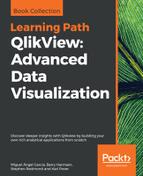Book Description
Build powerful data analytics applications with this business intelligence tool and overcome all your business challenges
Key Features
- Master time-saving techniques and make your QlikView development more efficient
- Perform geographical analysis and sentiment analysis in your QlikView applications
- Explore advanced QlikView techniques, tips, and tricks to deliver complex business requirements
Book Description
QlikView is one of the most flexible and powerful business intelligence platforms around, and if you want to transform data into insights, it is one of the best options you have at hand. Use this Learning Path, to explore the many features of QlikView to realize the potential of your data and present it as impactful and engaging visualizations.
Each chapter in this Learning Path starts with an understanding of a business requirement and its associated data model and then helps you create insightful analysis and data visualizations around it. You will look at problems that you might encounter while visualizing complex data insights using QlikView, and learn how to troubleshoot these and other not-so-common errors. This Learning Path contains real-world examples from a variety of business domains, such as sales, finance, marketing, and human resources.
With all the knowledge that you gain from this Learning Path, you will have all the experience you need to implement your next QlikView project like a pro.
This Learning Path includes content from the following Packt products:
- QlikView for Developers by Miguel Angel Garcia, Barry Harmsen
- Mastering QlikView by Stephen Redmond
- Mastering QlikView Data Visualization by Karl Pover
What you will learn
- Deliver common business requirements using advanced techniques
- Load data from disparate sources to build associative data models
- Understand when to apply more advanced data visualization
- Utilize the built-in aggregation functions for complex calculations
- Build a data architecture that supports scalable QlikView deployments
- Troubleshoot common data visualization errors in QlikView
- Protect your QlikView applications and data
Who this book is for
This Learning Path is designed for developers who want to go beyond their technical knowledge of QlikView and understand how to create analysis and data visualizations that solve real business needs. To grasp the concepts explained in this Learning Path, you should have a basic understanding of the common QlikView functions and some hands-on experience with the tool.
